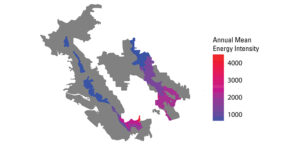
Water utilities’ pumps, valves, and other control devices generate actionable data; from these data sources it is possible to estimate the energy intensity of delivered water. Through partnership with Pacific Gas and Electric (PG&E) and East Bay Municipal Utility District (EBMUD) we have established a basic method for assessing the energy intensity of water delivery. Having worked out a defensible methodology, we are making our results available to others in the energy, water, and consulting industries, so that they can produce actionable insights for their customers as well. This information will enable direct improvements to water system management and may open the door to monetizing water conservation as a fungible commodity on carbon cap-and-trade markets.
[Read the paper published in the Journal of Industrial Ecology ]
Much of America’s water infrastructure is old, near functional obsolescence, and lacks 21st-century instrumentation and automation. Even so, water utilities’ pumps, valves, and other devices generate quite a bit of actionable data, and from these data sources it is actually possible to deduce the energy intensity of delivered water to a fair degree of accuracy.
We have advanced the state of this art through a partnership with Pacific Gas and Electric (PG&E) and East Bay Municipal Utility District (EBMUD) to establish a basic method for assessing the energy intensity of water delivery. Because they serve unique terrain and have different hydrologic conditions, no two water districts are identical; thus, we worked with EBMUD to map and analyze the energy signature of water delivered throughout much of its service area, taking into account the energy cost of pumping water over distances and elevations, and across seasons. The result is a map of energy intensity throughout the service delivery area and across time that elucidates the energy intensity of delivered water and enables intelligently targeted conservation efforts. We found that delivering a gallon of water to a home in the hills may demand four times the energy as would delivering the same gallon to a sea-level home. Possessing such nuanced and specific data on energy intensity will enable much more effective targeting for water–energy conservation programs.
We found that delivering a gallon of water to a home in the hills may demand four times the energy as would delivering the same gallon to a sea-level home. Possessing such nuanced and specific data on energy intensity will enable much more effective targeting for water–energy conservation programs.
Having worked out what we consider a defensible methodology, we hope to publish our results in 2013, making them available to others in the energy, water, and consulting industries, so that they can produce actionable insights for their customers as well. The value of this information is twofold. First, water utilities can use it to enhance their efficiency directly, by intelligently targeting conservation efforts and infrastructure upgrades, informed by the energy outcomes of their actions. In a time when resources are scarce and maintenance decisions are often made by the “wait until it breaks” method, the ability to target upgrades based on projected energy conservation offers an intelligent, effective alternative for proactive management. A conservation campaign or maintenance program directed at specific high-energy-intensity neighborhoods would thus yield outsized returns on energy reduction. Second, as water–energy efficiencies become more sophisticated, rigorous, and defensible, the possibility emerges of carbon-equivalency trading measured in water volumes saved. A water utility that conserves enough water could monetize that saving, offsetting some lost sales revenues by selling the carbon offset equivalent on the California–Québec international carbon market. Making water–energy efficiencies a fungible, exchangeable asset is now a question of policy, not of underlying science.
This method also lays the groundwork for a more detailed and sophisticated understanding of water system operations as a new generation of advanced, ubiquitous, low-cost sensors become available and embedded in the water infrastructure, and as new methods arise for bringing water infrastructure information from underground to the cloud.

